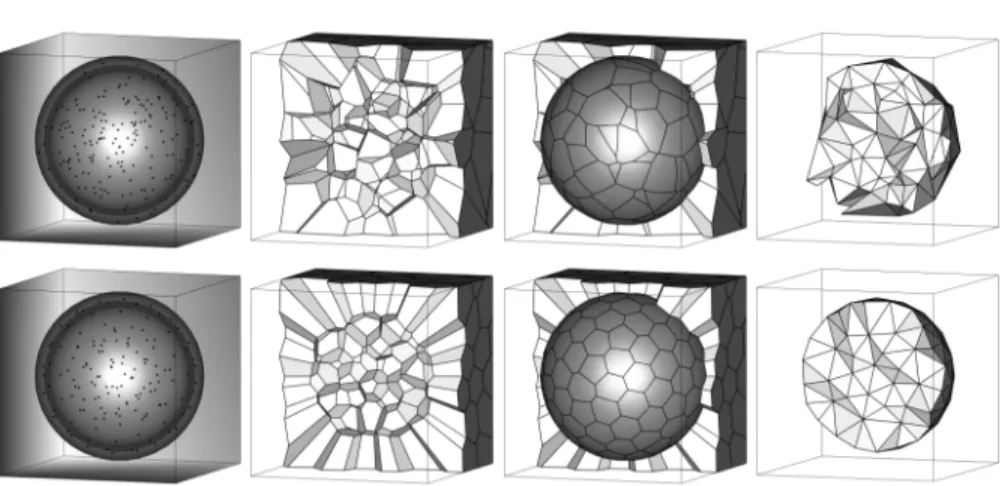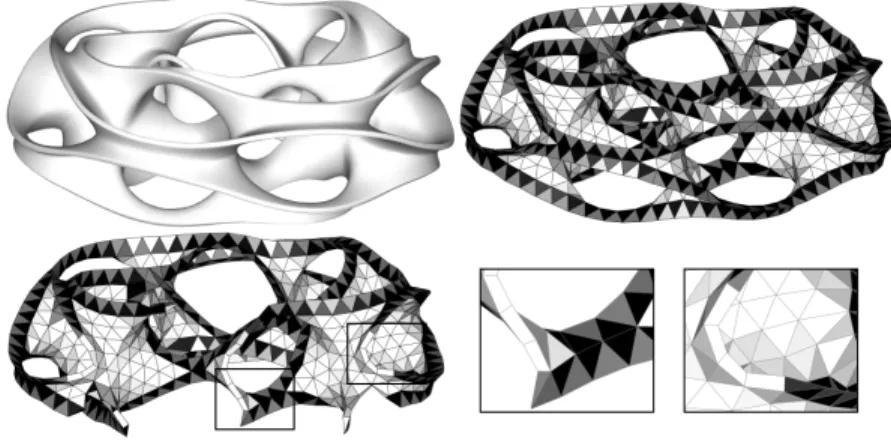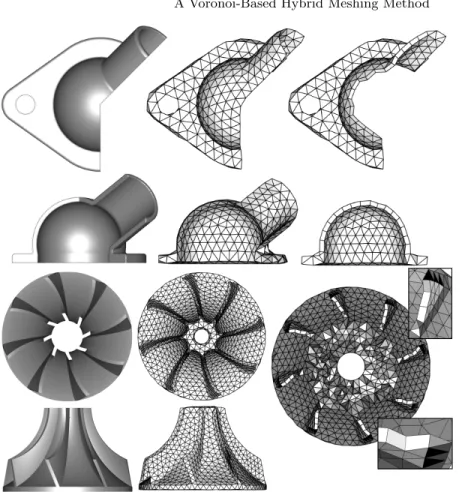HAL Id: hal-00770939
https://hal.inria.fr/hal-00770939
Submitted on 7 Jan 2013
HAL is a multi-disciplinary open access
archive for the deposit and dissemination of
sci-entific research documents, whether they are
pub-lished or not. The documents may come from
teaching and research institutions in France or
abroad, or from public or private research centers.
L’archive ouverte pluridisciplinaire HAL, est
destinée au dépôt et à la diffusion de documents
scientifiques de niveau recherche, publiés ou non,
émanant des établissements d’enseignement et de
recherche français ou étrangers, des laboratoires
publics ou privés.
A Voronoi-Based Hybrid Meshing Method
Jeanne Pellerin, Bruno Lévy, Guillaume Caumon
To cite this version:
Jeanne Pellerin, Bruno Lévy, Guillaume Caumon. A Voronoi-Based Hybrid Meshing Method. 2012.
�hal-00770939�
Jeanne Pellerin1, Bruno L´evy2, and Guillaume Caumon1
1 Universit´e de Lorraine-ENSG, Gocad Research Group, France
Jeanne.Pellerin@gocad.org, Guillaume.Caumon@gocad.org
2 Project ALICE, INRIA Nancy Grand-Est and LORIA, France
Bruno.Levy@inria.fr
Summary. In this research note we introduce a method to build volumetric hybrid meshes suitable for finite element computations. The generated mesh is conformal to a set of input surfaces; thin sections are meshed with prisms, pyramids, and tetrahedra, while the remaining of the domain is meshed with Delaunay tetrahedra.
1 Introduction
In geological modeling, building volumetric finite elements meshes suitable for fi-nite element computations is of crucial importance for many applications such as assessing natural resources or evaluating environmental risks and natural hazards. Geological models are multi-material models that can have a high number of inter-faces, these interfaces can come close to each other in certain zones and intersect at low-angles defining thin features that may have an impact on large scale nu-merical simulations. Meshing such models with Delaunay refinement based methods typically generates a very large number of elements, to avoid it we use prismatic, pyramidal, and tetrahedral elements in these zones.
We propose to adapt the elements of a tetrahedral dominant mesh to the local model configuration by generalizing the Voronoi-Delaunay dual relationship. The volume, defined by a set of triangulated surfaces, is sampled with a given number of points that optimize a function based on Centroidal Voronoi Tessellation (Sect. 3). From the Voronoi diagram of these points we identify the zones that can be meshed with their Delaunay triangulation, and the thin sections that cannot. The latter are filled with triangular prisms, square pyramids, and tetrahedra (Sect. 4). Some examples of hybrid meshes generated by the method are given in Sect. 5.
2 Goals
The input of our method is a set of triangulated surfaces defining a valid bound-ary representation model. Among the surfaces, we distinguish those constituting the external boundary, delimiting the zone of interest, from the internal boundaries (op-tional), that are interfaces between the different materials. The external boundary
2 Jeanne Pellerin, Bruno L´evy, and Guillaume Caumon
Fig. 1. Top: 200 points randomly distributed inside 3 nested spheres, their Voronoi diagram, its intersection with the external sphere and the Delaunay triangulation of the points. Bottom: After the optimization of the point positions, the sampling of the volume and the sampling of the spheres are isotropic, and the Delaunay tetrahedra are well-shaped. Note that the density of points is not sufficient to recover the thin layers sandwiched between the spheres. Our method uses prisms and pyramids to recover them (see Fig. 2, 3, and further).
must define the interior and the exterior of the model. In the current implementation, we assume that all interfaces cut the model into two parts.
The output of our method is a tet/prism/pyramid mesh that conforms to the geometry of the input boundary surfaces and to their topological relationships. In other words, a high-quality triangular remesh of the boundary surfaces appears as a subset of the facets of the volumetric elements. No preliminary identification of thin sections is needed; the size and resolution of the final mesh are controlled by the number of points (vertices of the final mesh) allocated to sample the model.
3 Sampling the Domain and the Boundary Surfaces
The first main step of our approach is to sample adequately the model and its boundary surfaces with a given number of points. A sampling, set of points S, can be characterized by its Voronoi diagram that associates to each point p ∈ S a cell containing the points of the space closer to this point p than to any other point of the sampling S. When each point of the sampling is at the centroid of its Voronoi cell, the Voronoi diagram is a Centroidal Voronoi Tessellation (CVT); and the dual Delaunay triangulation has well-shaped isotropic elements [1] (Fig. 2). When each point of the sampling which Voronoi cell intersects the surfaces is at the centroid of the intersection of its Voronoi cell with the surfaces, we have a Restricted Centroidal Voronoi Tessellation.Our current strategy to sample the model and its boundaries is to randomly distribute the points in the model, optimize their positions to obtain a CVT using
Lloyd relaxation and finally move the points near the boundary to obtain a restricted CVT to the surfaces as in [3]. Further work is needed to define a sampling quality relevant to the hybrid meshing method we propose. It is a crucial point, since the quality and validity of the final mesh elements depend upon it.
4 Hybrid Mesh Building
Once the points that define the vertices of the final hybrid mesh have been ade-quately placed, we build the edges, facets and cells. We first generate the triangular facets that remesh the model boundaries as in [2]. For each connected component of the intersection between a Voronoi cell and the model boundaries, we add one point; for each intersection between an edge of the Voronoi diagram and the model boundaries we build a triangle linking the points associated to the three neighboring restricted Voronoi cells (Fig. 2).
Then, the prisms filling the thin sections are built between the triangles cor-responding to two successive Voronoi edge-model boundary intersections (Fig. 2). Pyramids and tetrahedra are also obtained in the thin sections if the triangles defin-ing the element share one or two vertices. After meshdefin-ing the thin sections, we build the Delaunay triangulation of the points whose Voronoi cells do not intersect the model boundaries. The last elements to build are those linking the thin sections and the zones filled by tetrahedra. We add one hybrid cell for each vertex of the Voronoi diagram shared by 4 cells among which at least one intersects the model boundaries. We determine successively the vertices, edges, and facets of the cell to build from the intersections between the edges of the Voronoi diagram and the model boundaries. In a simple case the cell is a tetrahedron, but in a more complex configuration a post-processing is necessary to divide that cell into prisms, pyramids and tetrahedra.
Fig. 2. Prism building in a thin section between two close spheres. The Voronoi edges (black) and the intersections of the Voronoi cells with the spheres (grey) define the triangles remeshing the spheres and the prisms to build in the thin section.
5 Results
The first results of our meshing method applied to non-geological models are promis-ing particularly for smooth surfaces; meshes of the three nested spheres (Fig. 3)
4 Jeanne Pellerin, Bruno L´evy, and Guillaume Caumon
reproduce boundary layer meshes at different resolutions, thin models like the hep-tagonal toroid (Fig. 4) can be meshed with relatively few elements. For surfaces with sharp angles, the placement of the points has a crucial importance (Fig. 5), and the results could be improved by changing the point sampling strategy. We need to adapt the evaluation of the point sampling quality to our mesh extraction method and integrate it in the optimization of the point positions. In the current implementation, we check the errors of the meshing algorithm to assess the validity of the final mesh, this is indeed not sufficient and we need to work on a thorough check of the mesh validity and on an evaluation of the quality of its elements.
Fig. 3. Hybrid meshing of the three nested spheres (Fig.2) at different resolutions. The number of points used to sample the model (50; 200; 1000) determines the thin features. At all resolutions, we recover the two thin sections.
Fig. 4. Hybrid meshing of a smooth manifold surface of genus 22 with tetrahedra (grey), prisms (white) and pyramids (black).
Acknowledgments
This work is supported by the Gocad Consortium (www.gocad.org) and the Euro-pean Research Council (project GOODSHAPE, ERC-StG-205693).
Fig. 5. Hybrid meshing of models with sharp features. Thin sections are filled with prisms, pyramids and tetrahedra.
References
1. Qiang Du, Vance Faber, and Max Gunzburger. Centroidal Voronoi Tesselations: Applications and Algorithms. SIAM Review, 41(4):637–676, 1999.
2. Jeanne Pellerin, Bruno Levy, and Guillaume Caumon. Topological Control for Isotropic Remeshing of Non-Manifold Surfaces with Varying Resolution: Appli-cation to 3D Structural Models. In Proceedings of IAMG 2011, 2011.
3. Dong-Ming Yan, Bruno Levy, Yang Liu, Feng Sun, and Wenping Wang. Isotropic remeshing with fast and exact computation of restricted voronoi diagram. Com-puter Graphics Forum, 28(5):1445–1454, 2009.



